A MARRIAGE
OF MAN & MACHINE
Story & images by Vicki Andersen
Are you weary of over-groomed, over-civilized ski resorts? Do you yearn for
exhilarating runs without tedious liftlines or the drudgery of climbing snow-laden
slopes? Do you dream of cruising for miles, savoring the scenery and making
turns to your heart’s content? Then my advice to you is: GET A ROPE!
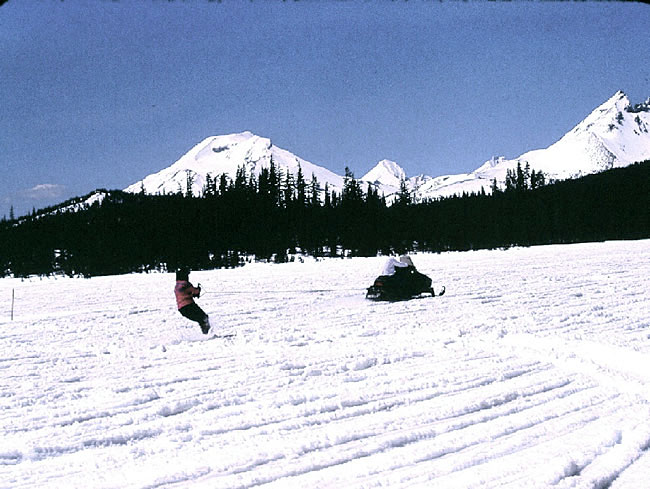 |
|
No, not the sometimes soggy, usually whiskered length of hemp that was the mainstay of uphill ski transport in the mid-twentieth century, but a rope for pulling. And something to attach it to for this delightful endeavor: dog, horse, or the most exhilarating and versatile of all - a snowmobile.
Referred to as ski-joring, we aren’t exactly sure how this exotic variation on skiing began. For centuries the Scandinavians harnessed their dogs, attached a rope, donned their skis and raced one another. Laplanders preferred holding reins attached to their reindeer. The name is derived from the Norwegian ski + jaring or driving, describing a winter sport in which a person on skis is drawn over snow or ice.
Whatever gave birth to this vision -- easier over-the-snow travel, an excuse
to exercise the critters, or Man’s unquenchable thirst for competition
-- it has caught the fancy of generations of skiers.
.jpg) |
|
|
Ski-Joring at Lake Placid Circa Early 1900s (photo
courtesy of North American Ski Joring Association)
|
Photos from the 1930s show folks, baggy woolen pants flapping in the wind, racing behind horses down the streets of St. Moritz, Switzerland. Equestrian ski-joring has developed into a highly specialized competitive sport where the skier must navigate a difficult course of gates and jumps. Speeds sometimes top 25 m.p.h., and distances in the “longest jump” competitions have exceeded 60 feet.
Ski-joring with dogs has become popular, with clinics and competitions springing up almost anywhere you find snow. A big disadvantage of using horses or dogs for your power source is the need to keep a wary eye out for “trail droppings”, and they aren’t too good at lugging their “cargo” up steep hills.
The bond of man and machine takes on a unique partnership at the Arctic Man Sno-Go Classic in Summit Lake, Alaska. Appropriately referred to as “The Ultimate Adrenaline Rush,” each April more than 10,000 spectators gather to watch highly skilled two-person teams challenge a 5-1/2 mile course.
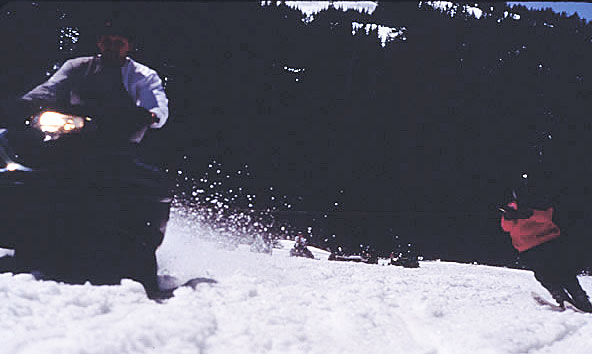 |
|
The skier starts at an elevation of 5,800 feet before plunging 1,700 feet in under two miles into the bottom of a canyon. In this narrow slot, the speeding skier meets up with his charging snowmobile partner who is dragging a tow rope, which the skier attempts to grab. If this synchronized high-speed merger goes well, they climb 2-1/4 miles uphill at speeds approaching 90 m.p.h. Definitely not a good time or place to catch an edge.
At the top of the second mountain, the skier lets go of the rope and slingshots into a 1,200-foot descent to the finish line. Encompassing both skiers and snowboarders, categories include Men’s Ski, Men’s Board, Women’s Ski and Women’s Board. Skiers are not allowed to use speed skis, speed helmets, body fairings or speed suits. Going stronger than ever for a dozen years, the slogan at Summit Lake has been “Go Fast or Go Home”.
Ski-joring behind a snowmobile gives you access to endless backcountry, frozen
lakes and untracked buttes. You can control where and how far you go, how fast
you travel, and you can always trade your towline for a ride back to camp if
you tucker out. Even well-conditioned skiers will discover ski-joring gives
leg and arm muscles a vigorous workout. Different than downhill or cross-country
skiing, with similarities to snowboarding and water-skiing, ski-joring is unlike
anything else you can do with skis or a snowboard.
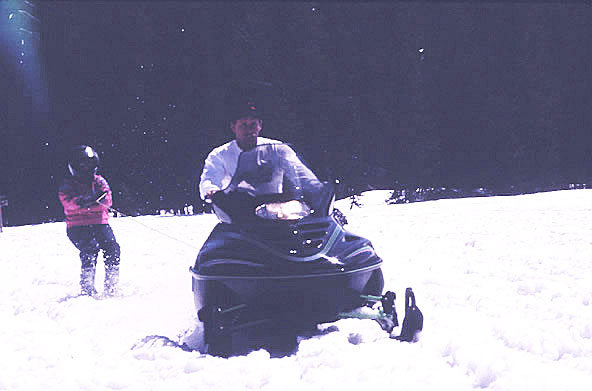 |
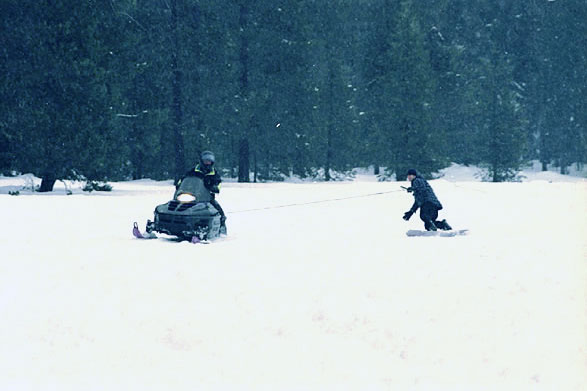 |
Imagine cruising on a wide trail or open meadow, throwing rooster-tails as you carve wide arcs through the snow. Feel yourself on a frozen lake, slicing signature tracks through the sastrugi. Experience the ascension of a backcountry butte: reaching the apex of your climb, you drop the rope and dance unfettered down the slope. At the bottom you ski up alongside the rope as the snowmobile slowly moves forward, retrieve it with an upward sweep of your gloved hand, and continue without pause for another journey to the top. Picture yourself on a trail between two towering, snow-clad banks, performing wall-hits that allow you to look down upon the machine that has you in tow.
If you are an intermediate-level snow slider (alpine or cross-country two-planker
or snowboarder), give ski-joring a try. Numerous snowmobile destinations, particularly
throughout the Pacific Northwest, have play areas close to the snowmobile sno-park
which provide the perfect terrain on which to start. In Oregon, Frog Lake at
Mt. Hood and the Dutchman Flat and Wanoga play areas at Mt. Bachelor are wonderful
examples of prime learn-to-ski-jor locations.
 |
|
You’ll need about a 20-25’ length of nylon rope to attach to the rear bumper of the snowmobile. A piece of wood or plastic used as a handle will make things easier, or if you’re a serious ski-jorer, a water-ski rope with padded grip is the ultimate way to go. Wear gloves and goggles -- eye protection is particularly important as chunks of snow can be thrown by the snowmobile track. If you have a helmet - ski, bicycle, motorcycle, in-line skate, or whatever - wear it.
Use hand signals to communicate with the driver: thumb up to increase speed, thumb down to slow, “slice” across the throat to stop, pat the top of your head to return to “base.” Stay loose and supple in your arms and legs, and don’t hesitate to drop the rope if you are uneasy. And remember to let go of the rope if you fall. When you start to move forward and the rope goes taut, keep your arms flexed and your feet underneath you. Straight arms won’t absorb jerking from the rope, leaning forward can tip you off balance, and inclining backward with the upper body puts you in an unbalanced position if the rope goes slack as you and the machine travel over changing terrain.
Note that ski-joring is NOT recommended as a method for teaching someone to
ski.
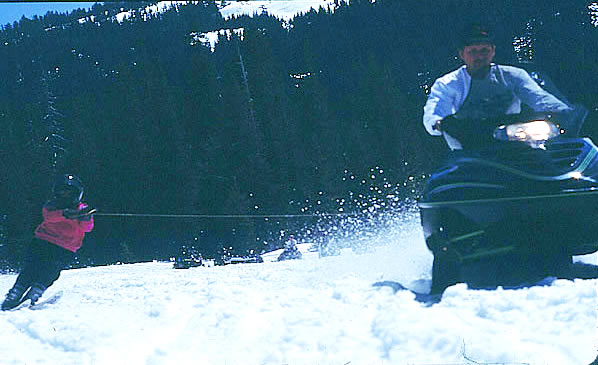 |
|
If you are operating the snowmobile, ease out slowly to remove the slack from the rope, then pick up speed. Somewhere around 18-20 m.p.h. is usually most comfortable for beginning ski-jorers, while more experienced folks will enjoy speeds around 30-35 m.p.h. You’ll feel the movement of the skier carving back and forth -- stay attuned to differentiating between the drag of a skier versus a loose rope bouncing around behind you. To equip your machine in earnest for this endeavor, consider adding a mirror (much easier to watch for hand signals) and a trailer hitch for a fixed, centered rope attachment.
This may be your portal to the unusual and exhilarating winter pastime that
has been beckoning ski and snowboard enthusiasts across North America.
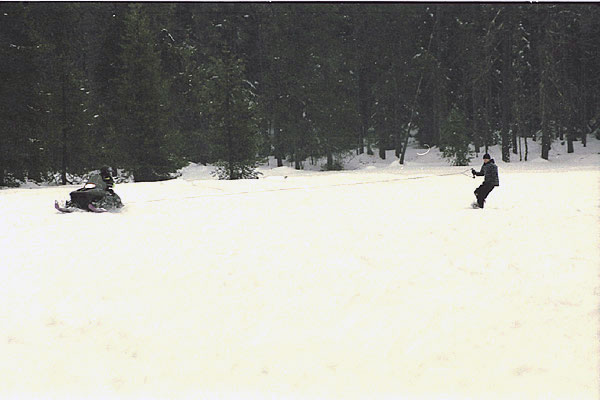 |
|
~~~
Vicki Andersen, member of the Society of American Travel Writers, North American
Snowsports Journalists Assn and Northwest Outdoor Writers Assn, is a freelance
journalist living in Portland, Oregon.
Vicki Andersen may be reached at: skicat1@comcast.net.